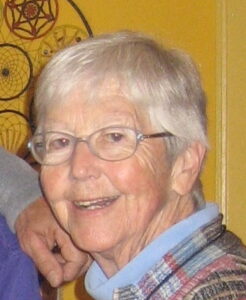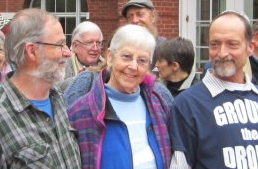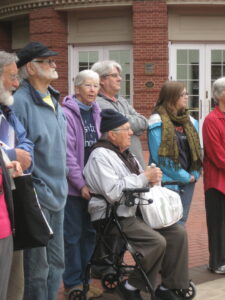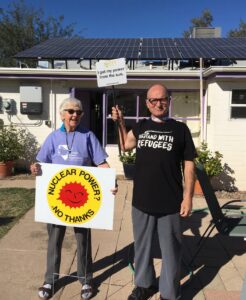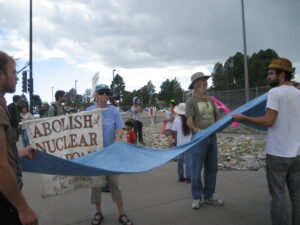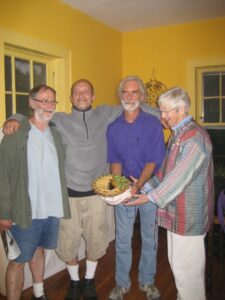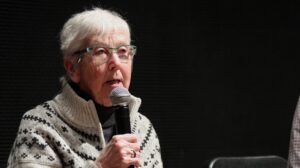Megan Rice, SHCJ Teacher, Pastoral Care Worker, and Activist
January 31, 1930 – October 10, 2021
Megan Rice, SHCJ, a Sister of the Society of the Holy Child Jesus, missionary, and ardent social justice advocate, died on Sunday, October 10, 2021, at Holy Child Center in Rosemont, Pennsylvania. She was 91. During her 71 years of ministry as a religious, Sister Megan became known internationally for her work in support of nuclear disarmament.
Sister Megan lived her life with love full of action and zeal,” said Carroll Juliano, American Province Leader for the Society of the Holy Child Jesus. “Her commitment to build a peaceful and just world was unwavering and selfless. She will be sorely missed, but her work will endure.”
From an early age, Sister Megan believed deeply in equity and justice for all, which was nurtured by her father, a physician, and her mother, a college professor. As a Sister of the Society of Holy Child Jesus, she dedicated her life to serving others, enthusiastically embracing the Society’s guiding principle “Actions Not Words.”
Sister Megan was born on January 31, 1930, in New York City and entered the Society of the Holy Child Jesus in 1947, immediately following her graduation from Saint Walburga’s Academy. Filled with a reservoir of compassion and faith, she made her final vows in 1955 and became well known by her religious name Mother Frederick Mary. Two years later, she earned a Bachelor of Science degree from Villanova University before continuing her education at Boston University, where she was awarded a Master of Science degree in 1962.
Sister Megan’s first ministry was as an educator. She taught for 12 years at various schools across the country, including, Saints Peter and Paul School in Fleetwood, New York (1950-1952 and 1956-1957), Saint Edward School in Philadelphia, Pennsylvania (1952-1954), Holy Spirit School in Philadelphia (1954-1956), and Saint Mary School in Melrose, Massachusetts (1957-1962).
While she loved teaching and spending time with her students, Sister Megan’s great desire was to minister in the Society of the Holy Child Jesus – African Province. In 1962, she was filled with joy when assigned to serve in Nigeria. For 23 years, she worked as a teacher, catechist, pastoral guide, and administrator in impoverished West African communities, which often lacked clean, running water, and electricity.
On her return to the United States in 1986, Sister Megan continued her work with marginalized communities, including at the Catholic Worker in New York City, Saint Mary Parish in Syracuse, New York, Jonah House in Baltimore, Maryland, and the Franciscan Center for Peace in Reno, Nevada.
Eventually, Sister Megan returned to the Society’s African Province where she served in religious education and pastoral care for several more years between 1991-2003.
Sister Megan’s missionary zeal and independent advocacy led her to peacefully protest for nuclear disarmament, as Catholic teaching condemns the use of nuclear weapons.
Sister Megan’s activism resulted in her arrest on numerous occasions and, at 82, being sentenced to three years in federal prison, where she was released after serving two years. Despite her selflessness and quiet demeanor, Sister Megan earned national recognition for her nuclear disarmament activism. She was featured on the front page of the New York Times, invited to testify before Congress, and the subject of a documentary. Sister Megan lived a life full of action in pursuit of justice and peace. Up until her final days, she was devoted to the Society’s mission to “rejoice in God’s presence and to help people believe that God lives and acts in them and our world.”
She joins her parents Frederick and Madeleine (Hooke) Rice and sisters, Cornelia Augusta (Alessandra Rice), SHCJ, and Madeleine (Rice) Finnerty, in eternal peace.
Services and interment are private.
From the Washington Post
Megan Rice, who crusaded against nuclear weapons, dies at 91
On its exterior wall the trio splashed human blood, as a symbol of the cost of war, and spray-painted biblical messages such as “THE FRUIT OF JUSTICE IS PEACE.”
Sister Megan Rice and her compatriots, Michael Walli and Greg Boertje-Obed, declared this an act of protest and love in the service of a higher law, but the incident prompted a two-week shutdown of the facility, and they were charged and convicted of intending to endanger the national defense. They spent about two years in prison, won release and vindication on appeal in 2015, and helped inspire other activists and works of journalistic nonfiction.
Sister Rice died Oct. 10 at the residence of her religious order, the Society of the Holy Child Jesus, in Rosemont, Pa. She was 91. The cause was congestive heart failure, said Colleen Carroll, the director of communications for the society.
“Has any empire or aspiring superpower not declined, not fallen apart from exceptionalism into decadence?” Sister Rice, dressed in a beige inmate jumpsuit, said in a Knoxville, Tenn., courtroom in February 2014. “So we had to come to this facility to call it to transformation.”
That facility, the Y-12 National Security Complex in Oak Ridge, Tenn., would not be transformed. It would instead proceed with the construction of a new uranium processing facility projected to cost over $6 billion.
But calling attention to the funding, possession and refurbishment of nuclear weapons — the United States is currently spending over $1 trillion to modernize its nuclear forces — was the capstone of Sister Rice’s lifelong commitments to education and anti-nuclearism, which took her from rural classrooms in Nigeria to desert peace marches in Nevada.
“She is a person of love,” Mary Evelyn Tucker, co-founder of the Forum on Religion and Ecology at Yale University and a lifelong friend of Sister Rice’s family, said at a sentencing hearing in 2014. Sister Rice is “in a great lineage of Gandhi, who transformed a nation, of Mandela . . . of Martin Luther King. She is in a lineage, clearly, that is transformative.”
Megan Gillespie Rice — her first name was pronounced “Mee-gan” — was born in New York City on Jan. 31, 1930. She was raised in Morningside Heights, near Columbia University, in a liberal Catholic environment attuned to poverty and human rights. Her parents, an obstetrician and a historian, were friends and followers of Dorothy Day and the Catholic Worker movement, which opposed the drumbeat of war even after the Japanese attack on Pearl Harbor.
As a child, Sister Rice was shaped by the examples of her mother, who wrote a dissertation on the Catholic Church’s timid position on slavery in the 19th century, and her teachers in the Society of the Holy Child Jesus, an order of sisters whose mantra was “actions not words.”
Sister Rice absorbed the social-justice sermons of her neighborhood pastor, civil rights champion George Barry Ford, and the horror stories of her uncle’s deployment to Nagasaki in the aftermath of the nuclear bombing of Japan in 1945.
By the end of high school, she was ready to commit her life to the Society of the Holy Child Jesus and follow in her teachers’ footsteps to Africa. After studying biology at Boston College and Villanova University, Sister Rice, who had taken the name Sister Frederick Mary, moved to southern Nigeria, where she helped build her own biology lab. She spent the next 40 years teaching in Africa.
In 2003, she decamped to Las Vegas to commit herself full time to anti-nuclear activism with the Nevada Desert Experience, an interfaith collective. In 2009, when a group of activists broke into a nuclear-weapons site in Washington state, Sister Rice took notice and attended their trial in Tacoma.
“Our intent was to keep the law,” testified defendant Anne Montgomery, herself an octogenarian Catholic sister. “To protect our lives as human beings and the lives of others.” Sister Rice was tantalized by this latest Plowshares action, an intrepid and dangerous form of activism that is designed to symbolically begin the work of transforming “swords into plowshares,” according to the Book of Isaiah.
Sister Rice’s slight frame and placid persona belied the physical undertaking of her intrusion at Y-12 and the magnitude of its repercussions. The break-in triggered congressional hearings, upended a government contract worth billions of dollars and prompted internal investigations by the Energy Department’s National Nuclear Security Administration.
“We want to thank you for pointing out some of the problems in our security,” Rep. Joe Barton (R-Tex.) said to Sister Rice during a hearing in 2012. “Mr. Chairman, that young lady there brought a Holy Bible. If she had been a terrorist, the Lord only knows what could have happened.”
Sister Rice viewed the break-in as an act of civil resistance against war, nuclear weapons and the resources expended on both. Government officials viewed it as a stunt and a crime, reckless and futile, though even the judge in her trial conveyed respect for her.
“Not only am I confident that you will live long past any sentence I give you, but I am sure that you will continue to use that brilliant mind you have,” Judge Amul Thapar told her in 2014 while sentencing her to two years and 11 months in prison. “I only hope you’ll use it to effectuate change in Washington rather than crimes in Tennessee.”
Sister Rice’s conviction was overturned in May 2015 by an appeals court, which viewed her crime as a protest, not as sabotage. She continued her activism through vigils, marches, prayers and visits to classrooms.
“I don’t feel like I’m free,” she told a group of activists in Oak Ridge on the 70th anniversary of the bombing of Hiroshima. “I’m not out of prison. None of us is out of prison as long as one nuclear bomb exists.”
From the New York Times
Sister Megan Rice, Fierce Critic of U.S. Nuclear Arsenal, Dies at 91
Arrested more than 40 times, she was best known for her role in the 2012 break-in at the Oak Ridge nuclear complex in Tennessee.
Sister Megan Rice, a Roman Catholic nun who was arrested more than 40 times for protesting America’s military industrial complex, most spectacularly for breaking into one of the world’s largest uranium storage sites, died on Oct. 10 at the residence of her religious order in Rosemont, Pa. She was 91.
Her order, the Society of the Holy Child Jesus, said in a statement that the cause was congestive heart failure.
Sister Rice was a leading figure among antiwar activists, especially the cohort of nuns and priests who saw protesting nuclear weapons as part of their religious calling.
She was already 82 when, in 2012, she and two other antinuclear activists, Greg Boertje-Obed and Michael Walli, hiked through the night over a steep ridge to the outskirts of the Y-12 National Security Complex in Oak Ridge, Tenn.
They used bolt cutters to get through three rings of barbed wire and approached the complex’s newest storage building, a windowless white-concrete hulk that had been billed as the “Fort Knox of uranium.”
They splashed blood against the walls and spray-painted slogans like, “The fruit of justice is peace” and “Woe to an empire of blood.” They lit candles and read an “indictment” against the American nuclear arsenal.
They were surprised at how lax the security was. Several of the cameras that should have captured their approach were broken or turned off, and it took almost half an hour before a single guard approached them. When he did, they broke a loaf of bread and offered him a piece. He refused.
The three activists were arrested and charged with trespassing and “destruction and depredation” of government property. When they refused to plead guilty, prosecutors added a charge of sabotage, carrying up to 20 years in prison.
“Please have no leniency on me,” Sister Rice said during the trial. “To remain in prison for the rest of my life would be the greatest honor you could give me.”
They served just two years and were released after an appeals court vacated the sabotage convictions — though Sister Rice said she would have gladly stayed in prison longer.
“It would be an honor,” she told a reporter for The New York Times soon after her release in 2015. “Good Lord, what would be better than to die in prison for the antinuclear cause?”
The episode at the nuclear complex was just one of many efforts by Sister Rice to take on the American military, a career that led to some 40 arrests — even she lost count — going back to the 1980s. And it was the capstone to a life steeped in progressive Catholicism.
Megan Gillespie Rice, who pronounced her first name MEE-gan, was born on Jan. 31, 1930, in the Morningside Heights section of Manhattan, to a family deeply involved in the Catholic progressive movement. Her father, Frederick Rice, was an obstetrician-gynecologist, and her mother, Madeleine Newman Hooke Rice, was a homemaker who later received a doctorate in history from Columbia.
Both of her parents were active in the Catholic worker movement and were close friends with its founder, Dorothy Day, who Sister Rice remembered visiting her family’s home in Morningside Heights.
Morningside Heights, home to Columbia University and venerable religious institutions like Riverside Church and Union Theological Seminary, was fertile ground for Sister Rice’s religious awakening. Father George Barry Ford, a leader in New York’s civil rights movement, preached at Corpus Christi Church on Columbia’s campus, where her family worshiped, and ran her elementary school.
During World War II, Sister Rice heard rumors about another side of her community: the professors from Columbia who were working on a top-secret government project. Its nature was revealed on Aug. 6, 1945, when the Americans dropped an atomic bomb on Hiroshima, Japan, and dropped another on Nagasaki three days later.
She recalled her mother thanking God for the attack; it meant that her uncle, who was to be part of the invasion of Japan, would now be spared. He went anyway, in the first wave of soldiers to reach Hiroshima after Japan surrendered, and he told her about the horrors he had encountered.
Megan joined the Society of the Holy Child Jesus in 1947 and took her final vows in 1955. She studied biology at Villanova University, and received a master’s degree in cellular biology from Boston College. She then moved to Africa, where she taught in elementary and secondary schools in Nigeria and Ghana.
She leaves no immediate survivors.
Starting in the 1980s, she made frequent trips to the United States, often to participate in antiwar actions.
Sister Rice left Africa for good in 2003. Two years later she moved to Nevada, where she joined an antiwar organization called the Nevada Desert Experience. She was arrested in 2009 during a protest against a missile test at Vandenberg Air Force Base (now Vandenberg Space Force Base) in California, and in 2011 for trespassing on Creech Air Force Base in Nevada, home to the country’s drone warfare program.
She traveled to Tacoma, Wash., in 2011 to observe the trial of several antiwar activists, including Sister Anne Montgomery, an 84-year-old nun, for trespassing on a nuclear submarine base. The trial inspired Sister Rice to plan a similar action of her own.
The protest at Y-12, a year later, made Sister Rice an international celebrity, and she used the spotlight to bring renewed attention to America’s efforts to modernize its nuclear arsenal.
“Sister Megan’s only regret about Y-12 was that she didn’t do something like that earlier,” said Carole Sargent, the author of the forthcoming book “Transform Now Plowshares: Megan Rice, Gregory Boertje-Obed, and Michael Walli.”
The complex shut down for two weeks, and Sister Rice’s incursion spawned Congressional hearings, where representatives thanked her for calling attention to the site’s poor security.
“That young lady there brought a Holy Bible,” said Representative Joe Barton, Republican of Texas. “If she had been a terrorist, the Lord only knows what would have happened.”
It was not the response Sister Rice was hoping for, but it didn’t stop her. After her release, she continued her antiwar activism, joining regular demonstrations outside the White House and the Pentagon.
Spending on nuclear weapons, she said in a 2019 interview, is “one of the root causes of, say, poverty in the United States, and therefore of crime.”
“It’s a root cause of many other issues because so much money is going into them,” she said.
Woman religious who crusaded against nuclear weapons dies at 91
Rosemont, PA — Sister Megan Rice, whose yearslong crusade against nuclear weapons included serving two years behind bars for a felony, died Oct. 10 at the Rosemont residence of her religious order, the Society of the Holy Child Jesus. She was 91.
Colleen Carroll, director of communications for the order, said the cause of death was congestive heart failure.
“It is incredible to consider how the bravery of this small, smiling, unassuming woman in standing up to the entirety of the U.S. military-industrial complex could bring so much awareness to the devastation our nation’s idolatry of nuclear weapons inflicts on people here in the U.S. and around the world,” Johnny Zokovitch, executive director of Pax Christi USA, said in a statement.
“All of Pax Christi USA grieves at her passing, but we give thanks for her witness, for her life and for the challenge that she issued by standing up nonviolently for a better world for all of us,” he said.
Sister Rice’s bold campaign against nuclear weapons launched her into the spotlight and caused her to become the issue’s ad hoc spokeswoman.
In July 2012, at age 82, she and two other members of Transform Now Plowshares breached security to stage a protest at the self-styled “Fort Knox of uranium,” the Y-12 National Security Complex in Oak Ridge, Tennessee. The facility creates and houses materials for making nuclear weapons.
The three activists cut through fences and reached the warehouse that stores bomb-making uranium. There, they splashed blood on the wall, hung banners and spray-painted messages condemning nuclear weapons.
The action sparked national shock and outrage, led to a congressional investigation of the security at Y-12 and sent Sister Rice and her companions, Michael Walli, then 63, and Greg Boertje-Obed, then 57, to prison.
On Feb. 18, 2014, in U.S. District Court, Sister Rice, of Washington, was sentenced to 35 months in prison on each of two counts — one count of depredation of property and one count of sabotage.
Walli, also of Washington, and Boertje-Obed, of Duluth, Minnesota, were sentenced to 62 months in prison each on the same counts.
The three had been convicted on the charges in May 2013 and held in prison since their convictions. Their sentences were to be served concurrently and the three were credited for the nine months they were held in prison.
All three had faced sentences of about six to 10 years on each count under federal sentencing guidelines. They all had participated in similar protests prior to their 2012 action.
The activism of Sister Rice, whose conviction was overturned by an appeals court in 2015, caught the attention of filmmaker and Emmy-winning producer Helen Young.
Young was already working on a documentary about this country’s nuclear arsenal. In April 2018, she released her film, “The Nuns, The Priests and The Bombs.”
Sister Rice toured the country to protest the United States’ nuclear arsenal as the star of the film. She also spoke to a congressional hearing and at the United Nations in New York City on the issue of nuclear disarmament.
And she continued her activism through vigils, marches, prayers and visits to classrooms.
“It’s illegal to deal in weapons of mass destruction — immoral and illegal,” Sister Rice declared during an April 8, 2018, event at the DeBartolo Performing Arts Center at the University of Notre Dame in South Bend, Indiana, where the documentary was being screened.
“We’re not being taken to the international court of justice and indicted the way Iran or some other place would,” she said.
Born Jan. 31, 1930, in New York City, Megan Gillespie Rice was the youngest of three girls in an Irish Catholic family.
Her father, Frederick W. Rice, was an obstetrician-gynecologist who taught at New York University and treated patients at several New York City hospitals.
Her mother, Madeleine Newman Hooke Rice, was a Barnard College graduate who took graduate courses studies at Columbia University while her children were growing up. She earned a doctorate in history and wrote her dissertation on Catholic views about slavery.
Sister Rice’s parents were active in the Catholic Worker Movement and were good friends of movement co-founder Dorothy Day.
Young Megan was educated in Catholic schools and joined the Sisters of the Holy Child Jesus at 18. She was trained as an elementary school teacher and taught in the early grades in Mount Vernon, New York.
During that time, she also was a part-time student at Fordham University and Villanova University. She earned a bachelor’s degree in biology at Villanova in 1957 and later received a master’s degree from Boston College.
She spent serval years teaching in Nigeria and Ghana, from 1962 to 2004.
In the 1980s, Sister Rice got involved in the anti-war movement, participating in protests against a variety of American military actions, military sites and nuclear weapons installations.
She was arrested more than three dozen times in acts of civil disobedience, including her anti-nuclear weapons activism.
from Cecile Pineda
My friend Megan Rice is dead at 91 years of age after a life time of helping others, part of it protesting nuclear weapons — weapons of mass destruction.
The account of her life can be read in this Washington Post article, a canned obit that manages to keep the truth of what went on at Y-12, the U.S. nuclear facility in Oakridge, TN, away from the eyes and minds of its readers.
I first met Megan in Nevada, the first year I went to protest the horror of drone warfare, and its destruction, not only of civilians, but of the entire social fabric of the many countries (Afghanistan, Iraq, Pakistan, Somalia, Libya, Yemen among them) drones target to this day. One of many protesters offering court support that day in 2010 at the trial of what came to be known as The Creech Fourteen, I witnessed the trial judge sentencing all fourteen resisters for time already served. Judge William Jansen had called for a recess of one month prior to that sentencing. During that time, despite the enormous pressure he must have felt from many government entities, he limited his sentencing to time served. Then he made a fatal mistake. He asked the defendants, many of whom are nationally prominent figures, all of them highly articulate people, if any of them had statements to make!
Megan Rice spoke first. We had been given a list of the fourteen, and brief biographies. From that list I knew Megan was a nun. I knew nothing more about her. But the fiery vigor by which she leaned in toward the judge and affirmed her belief that the use of drones by the U.S. government amounted to war crimes, overawed me. Who was this woman, I wondered? I had to find out.
Later that day, at lunch at the Nevada Desert Experience, Megan was one of many still sitting at table. I horned my way in next to her. I knew I had only the briefest time. I got right to the point. “I was educated by nuns.” “What Mother House?” Megan asked me. Mother House? I knew nothing of Mother House, so I said “I went to school with George Carlin.” “So did I,” said Megan, which is how we discovered we had been schoolmates two years apart at Corpus Christi elementary school, a progressive Manhattan grammar school, based on the learn-by-doing, collaborative ideas of John Dewey and the brain child of Father George B. Ford.
From that time on, Megan greeted the appearance of various of my newsletters with “How proud Father Ford would be that Corpus Christi graduated such a voice of resistance!”
I got to know more of Megan’s life when I took her to breakfast one time when she made a brief visit to Oakland. She told me of her 40 years in Africa, teaching children math and science. Meantime, morning traffic swarmed outside us.
“Slow down, slow down!” cried Megan. Over those 40 years she had done much more than teach, she had learned African time!
Megan was 85 when she was condemned to serve three years time, part of that in Ocilla, GA, one of the United States most notorious prisons. When she was transported to the Manhattan House of Detention, her warm underwear was taken from her. She had to endure the van trip from Georgia to New York in freezing conditions, without the protection of the underwear her loving friends had joined together to provide her.
But no matter what, Megan’s great grace was her never-ending smile, and her twinkling blue eyes. No matter what, with her faith, she had so much to be thankful for.
xxx
Remembering Sister Megan Rice: the ‘Joan of Arc’ of the anti-nuclear movement
After Megan Rice, S.H.C.J., died on Oct. 10 at the age of 91, her fellow sister, Carroll Juliano, S.H.C.J., said she “lived her life with love full of action and zeal,” a zeal that was the product of a community of inspirational influence.
She was once called a “Joan of Arc figure” by the Los Angeles Catholic Worker for her willingness to be arrested dozens of times at anti-nuclear protests, most famously in 2012 when she and associates trespassed at the Y-12 nuclear facility in Oak Ridge, Tenn. Sister Rice reached an inner area of the nuclear plant unscathed because “we were led miraculously,” she told reporters.
Having resolved not to harm any living thing during the protest, she vowed that if her group were attacked by guard dogs inside the complex, she would not raise her hands in self-defense, according to The Washington Post. Waiting to be handcuffed, she and her fellow protestors sang “This Little Light of Mine.”
Interviewed in the federal detention facility in Ocilla, Ga., she was asked if she feared spending the rest of her life in prison. Her selfless reply: “I have no family or dependents, and I am really not going to live that much longer.”
Indeed, at the ensuing trial she advised the judge: “Please have no leniency on me. To remain in prison for the rest of my life would be the greatest honor you could give me.” She also explained to the court, “We had to come to this facility to call it to transformation.”
The possibility of such transformations was instilled in Sister Rice at an early age. Her father, Frederick Rice, was an obstetrician and a gynecologist and taught at New York University, after serving in the New York National Guard’s 69th Regiment, known as the “Fighting Irish.” Dr. Rice also served on a family life committee for the Archdiocese of New York. Her mother, Madeleine Hooke, had her graduate thesis, American Catholic Opinion in the Slavery Controversy, published by Columbia University Press in 1944.
Both her parents were friends of Dorothy Day and hosted her in their Morningside Heights apartment. By age 18, Sister Rice had already decided to follow the example of her older sister, Alessandra, who took religious vows after attending Barnard College. The profound empathy she had seen her parents show toward African Americans made her want to go to Africa to teach. She had already begun to study at St. Walburga’s Academy of the Society of the Holy Child Jesus with Mary Laurentina Dalton, S.H.C.J., a pioneering instructor who encouraged her pupils to teach in Nigeria.
In order to teach in Nigeria, Sister Rice was required to obtain a graduate degree. She opted for a master’s degree in cellular biology, in which she used radioactive isotopes and learned about the effects of nuclear radiation. She was made further aware of radiation’s effects from her uncle Walter G. Hooke, who served as the driver for Paul Aijirō Yamaguchi, the archbishop of Nagasaki, Japan, after World War II; in that role he witnessed the devastation caused by the U.S. atomic attack on the city.
By 1977, Sister Rice was working in religious education in Nigeria, where she remained until 1986; starting in 1990, she taught in northern Ghana. In between these duties, while caring for her elderly mother in New York, Sister Rice would bring her mother along to protests, like the American Peace Test March in 1988, a nonviolent action campaign to protest nuclear weapon development at the Nevada Test Site near Las Vegas.
She eventually retired from missionary work due to the aftereffects of malaria and typhoid. Afterward, Sister Rice was arrested over a dozen times in acts of civil disobedience, including anti-nuclear weapons activism. In the 1990s, she was repeatedly jailed for trespassing during protests against torture at the U.S. Army’s School of the Americas (now the Western Hemisphere Institute for Security Cooperation) at Fort Benning, Ga., and served two six-month prison sentences.
Sister Rice was a proponent of the writings of Seymour Melman, a Columbia University professor of industrial engineering and operations research who wrote extensively on “economic conversion” from military to civilian productivity by military industries and facilities. For her, putting faith in weapons was simply idolatry, since armaments were false gods, fabricated for profit.
“It is incredible to consider how the bravery of this small, smiling, unassuming woman in standing up to the entirety of the U.S. military-industrial complex could bring so much awareness to the devastation our nation’s idolatry of nuclear weapons inflicts on people here in the U.S. and around the world,” Johnny Zokovitch, executive director of Pax Christi USA, said in a statement after her death. “All of Pax Christi USA grieves at her passing, but we give thanks for her witness, for her life and for the challenge that she issued by standing up nonviolently for a better world for all of us.”
